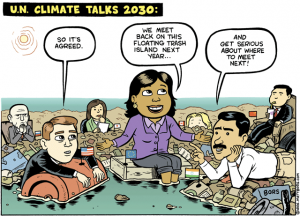
The COP 20 is hoped to make progress for the 2015 COP, the deadline COP the Ad Hoc Working Group on the Durban Platform for Enhanced Action (ADP) set for finishing negotiations for a new, more aggressive agreement between UNFCCC nations to combat climate change. As this deadline comes closer and closer, academics, delegates, NGOs and country leaders are scrambling to find the best type of new solution. Daniel Bodansky, of Arizona State University, explains that the three variables in international climate agreements, stringency, participation, and compliance, are all present in each negotiation, in various degrees depending on the nature of the agreement (Bodansky 2). For example, a top-down approach like that of the Kyoto Protocol in which international laws enforce internationally agreed-upon actions, leads to a greater degree of stringency and an uncertain outcome in terms of the participation and compliance variables. The level of presence for these two variables depends on whether the mutually-assured-compliance feature of top-down approaches is enough to convince states to take part and participate in the treaty (Bodansky 2). Conversely, the bottom-up approach like that of the Cancun Agreements where nations come up with their own commitments for international agreements, tend to have higher participation and commitment but low stringency (Bodansky 2). With advantages and disadvantages to both the bottom-up and top-down approaches, a mixed-track approach is the most promising structure for a 2015 agreement providing the increased ambition needed to act against climate change.
Not all scholars would agree that a mixed-track approach is the answer. David Shorr, an analyst of multilateral affairs, argues that the best way to go for the COP21 agreement is a top-down structure. He writes in his “Think Again: Climate Treaties”, “there is no substitute for high-level diplomacy in getting everyone to do their utmost and in keeping track of their efforts” (Shorr). Shorr acknowledges that there has been increased, and important, participation at the “bottom”, but when push comes to shove, a diplomatic treaty is a necessity in climate negotiations, quoting their stringency strengths through “keeping track of [countries’] efforts”. On the other side of the debate, Michael C. McCracken, the Chief Scientist for Climate Change Programs with the Climate Institute in Washington, D.C. argues that an international diplomatic agreement will not cut, as it has not for the past two decades. In his article “The Time to Act is Now”, McCracken argues that international agreements fail to inspire ambitious enough goals as signatories do not want to face punishments for goals they cannot keep (McCracken 15). Both McCracken and Shorr are correct in their own ways, but neither of their solutions will do enough on their own.
The multi-track approach Bodansky suggests, includes a combination of the strong points of both top-down and bottom-approaches, allowing in theory for the “best of both worlds”. He suggests offering various tracks of an agreement, allowing for nations to choose which tracks best suits their abilities, going off of the bottom-up approach. For example, one country might find it easiest to reduce greenhouse emissions as it is in desperate need of new infrastructure while another country may find it easier to develop and distribute new technologies aimed at a greener world (Bodanksy 9-10). The top-down aspect of this approach consists of a “core agreement” where economic-wide commitments are set out and a system for comparing different tracks’ efforts is established. Thus, an overall high level of stringency is achieved through a top-down core agreement alongside high levels of participation and compliance through bottom-up multi-track options. This structure offers the most promise looking forward to a 2015 agreement as it offers success in all three variables of success-measurement. Furthermore, those countries like the United States, who are not parties of the top-down Kyoto Protocol and those countries not parties to the Cancun Agreements are more likely to find a happy medium in a mixed-track agreement.
Works Cited
Bodansky, D., 2012. The Durban Platform: Issues and Options for a 2015 Agreement. Center for Climate and Energy Solutions.
MacCracken, M., 2014, “The time to act is now,” pp 13-19, G7 Summit 2014
Schorr, D., 2014, “Think Again: Climate Treaties” Foreign Policy: The Magazine. 17 March 2014. Web. 6 October 2014.
